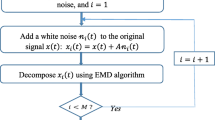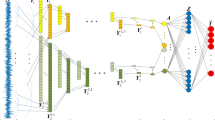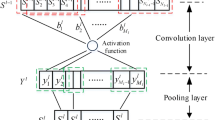Abstract
Deep learning has achieved much success in mechanical intelligent fault diagnosis in recent years. However, many deep learning methods cannot fully extract fault information to recognize mechanical health states when processing high-dimensional samples. Therefore, a multi-model ensemble deep learning method based on deep convolutional neural network (DCNN) is proposed in this study to accomplish fault recognition of high-dimensional samples. First, several 1D DCNN models with different activation functions are trained through dimension reduction learning to obtain different fault features from high-dimensional samples. Second, the obtained features are constructed into 2D images with multiple channels through a conversion method. The integrated 2D feature images can effectively represent the fault characteristic contained in raw high-dimension vibration signals. Lastly, a 2D DCNN model with multilayer convolution and pooling is used to automatically learn features from the 2D images and identify the fault mode of the mechanical equipment by adopting a softmax classifier. The proposed method, which is validated using the bearing public dataset of Case Western Reserve University, USA and a one-stage reduction gearbox dataset, has high recognition accuracy. Compared with other classical deep learning methods, the proposed fault diagnosis method has considerable improvements.
Similar content being viewed by others
Abbreviations
- 1D:
-
One-dimensional
- 2D:
-
Two-dimensional
- conv:
-
Convolutional layer
- CNN:
-
Convolutional neural network
- DBN:
-
Deep belief network
- DCAE:
-
Deep convolutional autoencoder
- DCNN:
-
Deep convolutional neural network
- DNN:
-
Deep neural network
- DR:
-
Dropout layer
- FC:
-
Fully-connected layer
- IR:
-
Inner race fault state of the bearing in case study 1
- MMEDL:
-
Multi-model ensemble deep learning
- N:
-
Normal state of the bearing in case study 1
- OR:
-
Outer race fault state of the bearing in case study 1
- pool:
-
Max pooling layer
- RE:
-
Rolling element fault state of the bearing in case study 1
- SVM:
-
Support vector machine
- t-SNE:
-
t-distributed stochastic neighbor embedding
- b :
-
bias of the neurons in Eq. (1)
- d k :
-
Length of the trainable filters in Eq. (1)
- k :
-
Trainable filters in Eq. (1)
- L c :
-
Length of the gear crack in case study 2
- R c :
-
Radius of the root circle of the main driving wheel in case study 2
- r h :
-
Radius of the center hole of the main driving wheel in case study 2
- x :
-
Input of the convolution layer in Eq. (1)
- s :
-
Nonlinear activation functions in Eq. (1)
References
Liu R, Yang B, Zio E, et al. Artificial intelligence for fault diagnosis of rotating machinery: A review. Mechanical Systems and Signal Processing, 2018, 108: 33–47
Zhang H. Fault diagnosis and life prediction of mechanical equipment based on artificial intelligence. Journal of Intelligent & Fuzzy Systems, 2018, 37(3): 3535–3544
Jia F, Lei Y, Guo L, et al. A neural network constructed by deep learning technique and its application to intelligent fault diagnosis of machines. Neurocomputing, 2018, 272: 619–628
Liu J, Hu Y, Wang Y, et al. An integrated multi-sensor fusion-based deep feature learning approach for rotating machinery diagnosis. Measurement Science & Technology, 2018, 29(5): 055103
Azamfar M, Li X, Lee J. Intelligent ball screw fault diagnosis using a deep domain adaptation methodology. Mechanism and Machine Theory, 2020, 151: 103932
Ainapure A, Li X, Singh J, et al. Enhancing intelligent cross-domain fault diagnosis performance on rotating machines with noisy health labels. Procedia Manufacturing, 2020, 48: 940–946
Zhang X, Guo S, Jiang L. Semi-supervised fault identification based on improved Laplace feature mapping and constraint seed K-means. Journal of Vibration and Shock, 2019, 38(16): 93–99 (in Chinese)
Widodo A, Yang B S. Support vector machine in machine condition monitoring and fault diagnosis. Mechanical Systems and Signal Processing, 2007, 21(6): 2560–2574
Sun Y, Zhang S, Miao C, et al. Improved BP neural network for transformer fault diagnosis. Journal of China University of Mining and Technology, 2007, 17(1): 138–142
Liu J, Hu Y, Wu B, et al. A hybrid generalized hidden markov model-based condition monitoring approach for rolling bearings. Sensors (Basel), 2017, 17(5): 1143
Hoang D T, Kang H J. A survey on deep learning based bearing fault diagnosis. Neurocomputing, 2019, 335: 327–335
Li X, Li J, Qu Y, et al. Semi-supervised gear fault diagnosis using raw vibration signal based on deep learning. Chinese Journal of Aeronautics, 2020, 33(2): 418–426
Zhang W, Li C, Peng G, et al. A deep convolutional neural network with new training methods for bearing fault diagnosis under noisy environment and different working load. Mechanical Systems and Signal Processing, 2018, 100: 439–453
Schmidhuber J. Deep learning in neural networks: An overview. Neural Networks, 2015, 61: 85–117
Tang S, Yuan S, Zhu Y. Deep learning-based intelligent fault diagnosis methods toward rotating machinery. IEEE Access: Practical Innovations, Open Solutions, 2020, 8: 9335–9346
Jing L, Wang T, Zhao M, et al. An adaptive multi-sensor data fusion method based on deep convolutional neural networks for fault diagnosis of planetary gearbox. Sensors (Basel), 2017, 17(2): 414
Zhu J, Hu T, Jiang B, et al. Intelligent bearing fault diagnosis using PCA-DBN framework. Neural Computing & Applications, 2020, 32(14): 10773–10781
Lecun Y, Bottou L, Bengio Y, et al. Gradient-based learning applied to document recognition. Proceedings of the IEEE, 1998, 86(11): 2278–2324
Zhao D, Wang T, Chu F. Deep convolutional neural network based planet bearing fault classification. Computers in Industry, 2019, 107: 59–66
Chen H, Hu N, Cheng Z, et al. A deep convolutional neural network based fusion method of two-direction vibration signal data for health state identification of planetary gearboxes. Measurement, 2019, 146: 268–278
Wu C, Jiang P, Ding C, et al. Intelligent fault diagnosis of rotating machinery based on one-dimensional convolutional neural network. Computers in Industry, 2019, 108: 53–61
Kumar A, Zhou Y, Gandhi C P, et al. Bearing defect size assessment using wavelet transform based deep convolutional neural network (DCNN). Alexandria Engineering Journal, 2020, 59(2): 999–1012
Li Y, Du X, Wan F, et al. Rotating machinery fault diagnosis based on convolutional neural network and infrared thermal imaging. Chinese Journal of Aeronautics, 2020, 33(2): 427–438
Wen L, Li X, Gao L, et al. A new convolutional neural network-based data-driven fault diagnosis method. IEEE Transactions on Industrial Electronics, 2018, 65(7): 5990–5998
Xue Y, Dou D, Yang J. Multi-fault diagnosis of rotating machinery based on deep convolution neural network and support vector machine. Measurement, 2020, 156: 107571
Hu Z X, Wang Y, Ge M F, et al. Data-driven fault diagnosis method based on compressed sensing and improved multiscale network. IEEE Transactions on Industrial Electronics, 2020, 67(4): 3216–3225
Li H, Huang J, Ji S. Bearing fault diagnosis with a feature fusion method based on an ensemble convolutional neural network and deep neural network. Sensors (Basel), 2019, 19(9): 2034
Zhou Q, Li Y, Tian Y, et al. A novel method based on nonlinear auto-regression neural network and convolutional neural network for imbalanced fault diagnosis of rotating machinery. Measurement, 2020, 161: 107880
Pezzotti N, Lelieveldt B, Maaten L, et al. Approximated and user steerable tSNE for progressive visual analytics. IEEE Transactions on Visualization and Computer Graphics, 2017, 23(7): 1739–1752
Smith W A, Randall R B. Rolling element bearing diagnostics using the case western reserve university data: A benchmark study. Mechanical Systems and Signal Processing, 2015, 64–65: 100–131
Srivastava N, Hinton G, Krizhevsky A, et al. Dropout: A simple way to prevent neural networks from overfitting. Journal of Machine Learning Research, 2014, 15(1): 1929–1958
Agostini C E, Sampaio M A. Probabilistic neural network with bayesian-based, spectral torque imaging and deep convolutional autoencoder for PDC bit wear monitoring. Journal of Petroleum Science Engineering, 2020, 193: 107434
Jia F, Lei Y, Lin J, et al. Deep neural networks: A promising tool for fault characteristic mining and intelligent diagnosis of rotating machinery with massive data. Mechanical Systems and Signal Processing, 2016, 72–73: 303–315
Zhang X, Guo S, Li Y, et al. Semi-supervised fault identification based on laplacian eigenmap and deep belief networks. Journal of Mechanical Engineering, 2019, 56(1): 69
Gong W, Chen H, Zhang Z, et al. A novel deep learning method for intelligent fault diagnosis of rotating machinery based on improved CNN-SVM and multichannel data fusion. Sensors (Basel), 2019, 19(7): 1693
Acknowledgements
This study was financially supported by the National Key R&D Program of China (Grant No. 2017YFD0400405).
Author information
Authors and Affiliations
Corresponding author
Rights and permissions
About this article
Cite this article
Zhang, X., Huang, T., Wu, B. et al. Multi-model ensemble deep learning method for intelligent fault diagnosis with high-dimensional samples. Front. Mech. Eng. 16, 340–352 (2021). https://doi.org/10.1007/s11465-021-0629-3
Received:
Accepted:
Published:
Issue Date:
DOI: https://doi.org/10.1007/s11465-021-0629-3




